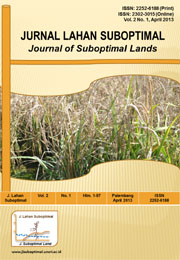Oil Palm Fruit Bunch Yield Fluctuation between Dry and Rainy Season in Dry and Wetland
DOI:
https://doi.org/10.33230/JLSO.2.1.2013.31Keywords:
Dry land, Wetland, Yield fluctuationAbstract
The objective of this research was to study how much yield difference of fresh fruit bunch of oil palm between dry and rainy season, and whether the yield difference much in dry land compare with wetland. The research was conducted in Entisol of PTPN VII Betung, and in Ultisol of PTP Hindoli, both in Sungai Lilin Regency. Yield data used in this study was data of year 2007−2010. Rainfall data during 2007−2010 showed no absolute dry month during dry seasons. The result of the study indicated that yield in dry land higher than in wetland either in dry season or in rainy season. Yield fluctuated between dry and rainy season either in dry land or in wetland. But, yield in rainy season did not consistently higher than in dry season. It was concluded that oil palm yield was influenced not only by soil water supply and rainfall quantity, but also internal and many other external factors.Downloads
Published
2013-11-19
How to Cite
Priadi, D. P., Abuchatam, N., & Simangunsong, J. (2013). Oil Palm Fruit Bunch Yield Fluctuation between Dry and Rainy Season in Dry and Wetland. Jurnal Lahan Suboptimal : Journal of Suboptimal Lands, 2(1). https://doi.org/10.33230/JLSO.2.1.2013.31
Issue
Section
Articles
License
Copyright (c) 2013 Dwi Putro Priadi, Nusyirwan Abuchatam, J. Simangunsong

This work is licensed under a Creative Commons Attribution-NonCommercial-ShareAlike 4.0 International License.













